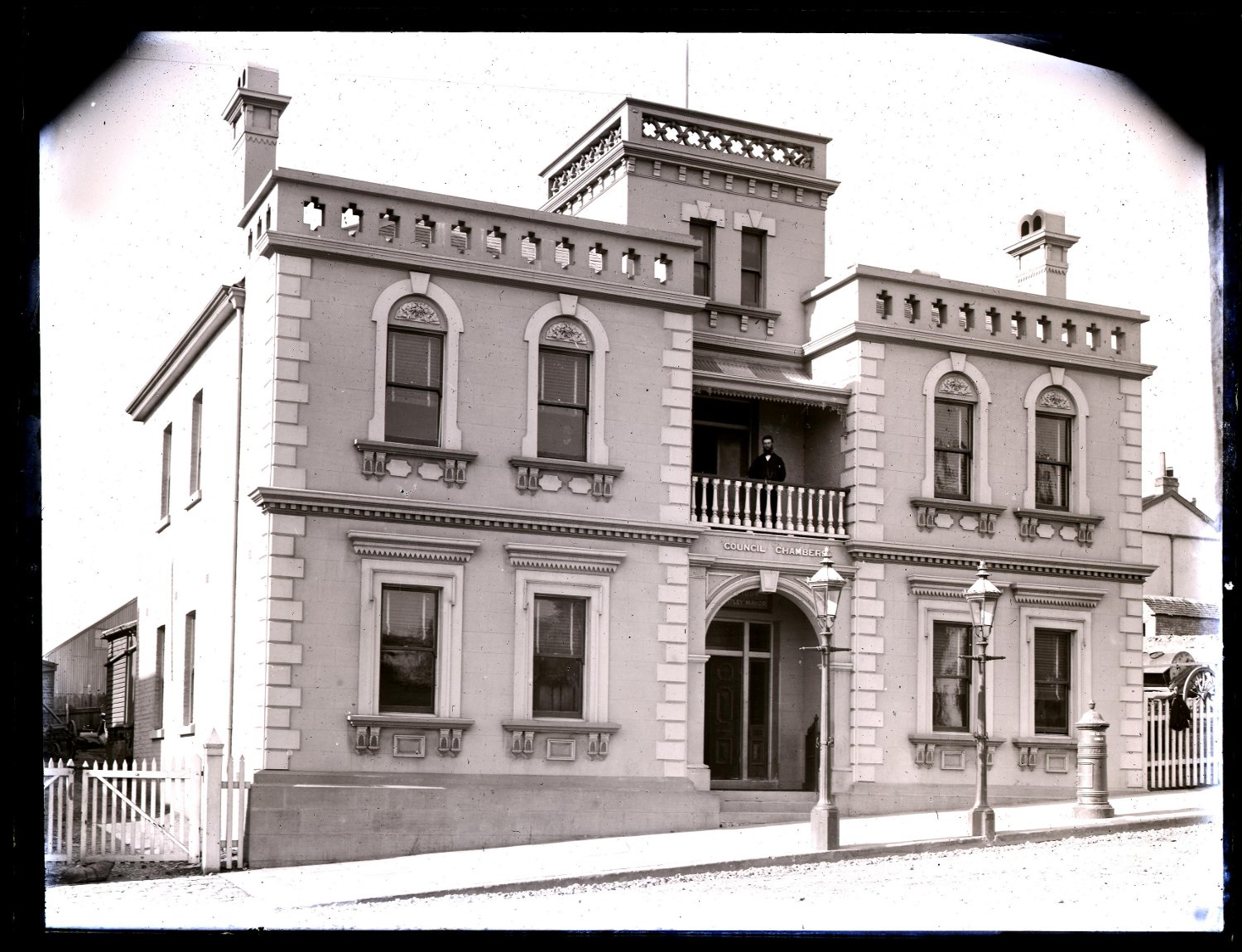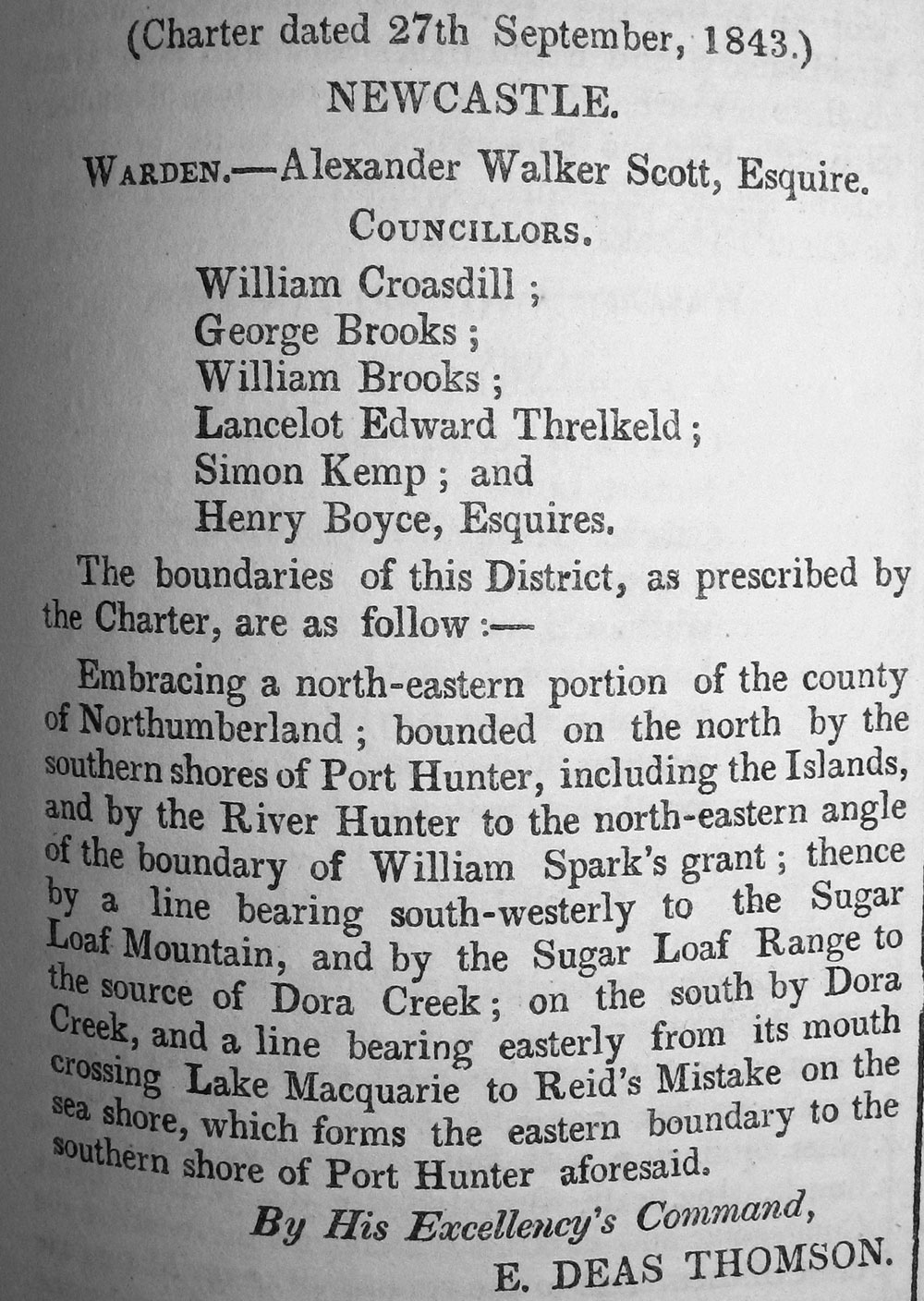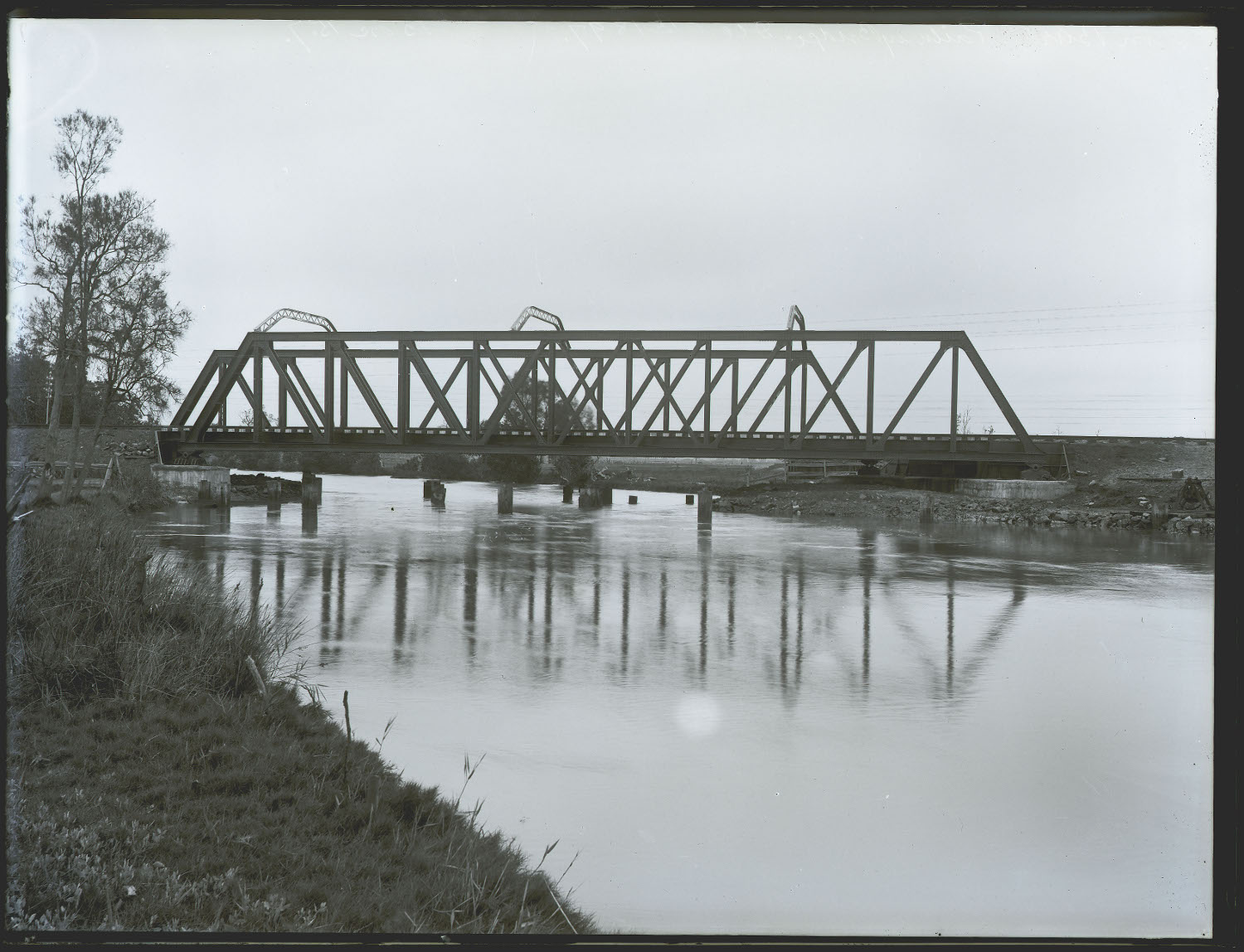How did local government come to Town?
How did local government in the form of the Newcastle City Council come to be? The Local Government Area, of which Newcastle city is its centre, has gone through a number of name changes over the years.
Since 1993 it has been known as The Newcastle City Council (1993+).
Former titles have included:
Newcastle District Council (1843-1858);
The Municipality of Newcastle (1859-1867);
The Borough of Newcastle (1867-1938);
The City of Greater Newcastle (1938-1949);
City of Newcastle (1949-1993).
The chief elected officer was once the Warden (1843-1858), then Mayor (1859-1947) and now The Right Worshipful The Lord Mayor of Newcastle (1948+). The chief executive officer was the Town Clerk (1859-1993) and now is the General Manager (1993+).
Newcastle was founded in 1801, abandoned and re-established in 1804 as a penal settlement and the Nation’s first profitable source of coal and cedar for the emerging Colony. Prior to 1843 The Governor of New South Wales was in charge of all governmental responsibilities. In Newcastle, these orders were carried out by appointed military commanders.
When Newcastle ceased to be a penal settlement and the region became open to free settlers in the 1820s, it soon became apparent that the colonial government could not provide adequate local services, and therefore the opportunity emerged to establish municipal district councils (NSW Department of Education and Training, 2004).
The first local councils in New South Wales were incorporated under the provisions of the Imperial Act of 1842. From 1843 individual councils were established and administered by a government-appointed warden. (State Records Authority of New South Wales, 2008)
Published in the NSW Government Gazette of 10 October 1843 was the Charter dated 27 September 1843 with a notification from the Governor of a Letters Patent incorporating the inhabitants of a number of districts including the Newcastle District Council to be administered by a Warden and six Councillors. The first Warden was Mr Alexander Walter Scott, and the Councillors were William Croasdill, George Brooks, William Brooks, Lancelot Edward Threlkeld, Simon Kemp and Henry Boyce.
The Newcastle District Council’s functions were to distribute the allocation of Government funds for the purposes of road repairs and bridges especially in Newcastle’s case, the Iron Bark Bridge (Goold, n.d, 5).The Newcastle District Council’s functions were to distribute the allocation of Government funds for the purposes of road repairs and bridges especially in Newcastle’s case, the Iron Bark Bridge (Goold, n.d, 5).
Due to public disquiet as to the Sydney centric distribution of Government funds, The Municipalities Act of 1858 provided for a system of incorporation that could be granted to townships on the proviso that a petition of at least 50 signed householders was received. The Governor could then proclaim the municipality. (Larcombe, 1973, p.261)
Before we all get confused, (like I am) a ‘municipality’ is a legal instrument defined in 1858 to define an area of land for the purposes of local government no larger than 10 square miles and with a minimum population of 500. A ‘borough’ is the area containing inhabitants that is incorporated under that legal instrument. So a ‘borough’ was originally defined as a place with houses, a step up from a ‘town’, but not as big as a ‘city’.
On the 27 October 1858 the Municipalities Act was passed by the NSW Government. The first meeting of Newcastle’s inhabitants to discuss the provisions of the Act was held on the 8 November 1858. It was a success, with a petition being sent to the Governor of the intention of the district’s 2,400 inhabitants calling for the township to become a municipality. (Goold, n.d, 5)
Municipalities Act 1858 [3.9MB PDF file]. No. XIII An Act for establishing Municipal Institutions. [27th October, 1858]
The Proclamation by His Excellency Sir William Thomas Denison that created The Municipality of Newcastle was officially signed at Government House Sydney on the 7 June 1859, and published the following day in the NSW Government Gazette. (Goold, n.d, 7 and NSW Government Gazette, 1859, 1293-1294)
Download the Proclamation – Proclamation – 7 June 1859 [620KB PDF]
Each municipality was to be governed by an elected Council of 6-9 members. Newcastle was incorporated in 1859 and its first elected Mayor was Mr James Hannell. Three Wards were proclaimed; The City Ward to be governed by 9 councillors, The Macquarie Ward and the Honeysuckle Ward consisting of 5 councillors each. The Municipality of Newcastle existed under that title from 8 June 1859 – 22 Dec 1867.
The original meetings were held in the old courthouse building that originally occupied the site on the corner of Hunter and Bolton Streets, it was demolished to build the magnificent Newcastle Post Office.
From 1884 onwards the meetings were held in the Council Chambers in Watt Street (still existing and now occupied by the United Services Club).
As the population grew, residents from surrounding mining townships began petitioning for their own townships to be incorporated under the Municipalities Act of 1858. These included Wallsend (1874); Plattsburg (1876); Hamilton, Lambton, Wickham and Waratah (1871); Adamstown and Merewether (1885); Carrington (1887); New Lambton and Stockton (1889). (Windross & Ralston, 1897, p.35)
The Municipality of Newcastle became The Borough of Newcastle on the 23 December 1867 after The Municipalities Act of 1867.
Download the 1867 Municipalities Act here – 1867 Municipalities Act [22MB PDF]
The Act came into force in order to avoid legal difficulties that arose between the administration of urban and rural areas. Under the new Act rural and urban areas would be divided into municipal districts which could not be less than 500 people (rural units) and municipal boroughs with a population that could not be less than 1,000 (urban units). (Larcombe, 1976, p.150) The Municipalities Act of 1867 declared that the existing 35 municipalities, of which Newcastle was one, be legally constituted as boroughs. Each would be governed by elective councils of 6-12 aldermen, and if divided into wards were to have three representatives for each. (Larcombe, 1976, p.158)
Huntington in his ‘History of Newcastle and the Northern District’, (which was a history of Newcastle published as a serial in the Newcastle Herald from 1897-1898), said that the boundaries of Newcastle were proclaimed back on the 14 December 1858 under the Towns Police Act, and that the city boundaries proclaimed later on the 20 March 1885 were identical to them. Newcastle was proclaimed a city on the 20 March 1885 (or 22 March 1885 under the Crown Lands Act according to Maiden p.246), and proclaimed a borough on the 14 September 1886. The wards, which were called City, Honeysuckle and Belmore were proclaimed on the 14 September 1886. (Huntington, pp. 209-210)
The boundaries of the Newcastle City Council have been progressively expanding over time. The biggest expansion occurred in 1938 when the City absorbed eleven (11) surrounding suburban municipalities.
On the 1st April 1938 the City of Greater Newcastle came into being after the Greater Newcastle Act 1937.
Download the Greater Newcastle Act 1937 here – 1937 Greater Newcastle Act [5.5 MB PDF]
The idea for a greater Newcastle had originally been proposed in the 1890s and reached wider public discussion in February 1901 when the local State politician Arthur Griffith (1861-1946) suggested that if all the councils of Newcastle were to amalgamate a grant of 30,000 pounds (twice the municipal income of the time) would be provided to assist the process. The idea was furthered over the next thirty years by its champions John D. Fitzgerald (1862-1924), Robert G Kilgour (1867-1938) President of the Greater Newcastle League, William M. Shedden (1862-1933) and finally Eric J. Spooner (1891- 1952) who was instrumental in bringing it to fruition through the Greater Newcastle Act that became law on the 15th December 1937. (Docherty, 1983, pp143-153)
When did the ‘Mayor’ become a ‘Lord Mayor’?
According to Maiden, the title of Lord Mayor’ was only to be bestowed on Mayors of capital cities. (Local Government Department Report 1947-8). Due to the population growth of the Greater Newcastle area, its outstanding position as coal port and industrial powerhouse, and status as second oldest city the Newcastle City Council applied to have the title and in October 1947 His Majesty approved the application. The Letters Patent conferring the title of Lord Mayor was sent to Council in October 1948 and from then on the official title was ‘The Right Worshipful The Lord Mayor of Newcastle’. (Maiden, pp.246-247)
On 1 April 1949 the official title became City of Newcastle. (S. Ryan, personal communication, April 4, 2008).
The Local Government Act 1993 superseded the 1919 Act and created formal distinctions between the elected Council and its administration replacing the title of Town Clerk with the General Manager.
The Newcastle City Council has two main divisions consisting firstly of the elected Council made up of the Lord Mayor and twelve (12) councillors, and secondly of the administration run by the General Manger. The administration (just before its 2009 restructure) consisted of six groups: Executive Management – Governance, Executive Management – Human Resources Management Unit, Corporate Services (CORPS), City Services (CITYS), Strategic Planning and Development (SPD) and Community Development (CD).
The broad policy directions of the public organisation stem from the elected councillors and Lord Mayor. They discuss and decide upon what services are to be provided by the Council. The General Manager is the person then instructed to put into action the outcomes of those decisions. The General Manager deals with the six divisions of the administration delegating the policy and planning decisions to the managers of the various groups.
Preceding agencies or municipal councils:
Adamstown Council – incorporated on 31 December 1885 and proclaimed as a Municipality in the NSW Government Gazette, 8 January 1886.
Carrington Council – incorporated on the 28 March 1887 and proclaimed as a Municipality in the NSW Government Gazette, 30 March 1887.
Hamilton Council – proclaimed as a Municipality in the NSW Government Gazette, 11 December 1871.
Lambton Council – incorporated on 24 June 1871 and proclaimed as a Municipality in the NSW Government Gazette, 26 June 1871.
Merewether Council – proclaimed as a Municipality in the NSW Government Gazette, 20 August 1885.
New Lambton Council – proclaimed as a Municipality in the NSW Government Gazette, 9 January 1889.
Plattsburg Council – proclaimed as a Municipality in the NSW Government Gazette, 27 December 1876. The Municipality ceased to exist in 1915 when it was incorporated in the Municipality of Wallsend.
Stockton Council – proclaimed as a Municipality in the NSW Government Gazette, 14 October 1889.
Wallsend Council – proclaimed as a Municipality in the NSW Government Gazette, 27 February 1874. In 1915 the Municipality of Plattsburg was incorporated with the Municipality of Wallsend.
Waratah Council – proclaimed as a Municipality in the NSW Government Gazette, 23 February 1871.
Wickham Council – proclaimed a Municipality in the NSW Government Gazette, 27 February 1871.
Record series created by this agency:
Minute books of councils and council committees at Newcastle 1859+, Wickham 1871+, Waratah 1871+, Lambton 1871+, Hamilton 1872+, Wallsend 1874+, Plattsburg 1877+, Merewether 1885+, Adamstown 1886+, Carrington 1887+, Stockton 1889+, and New Lambton 1935+
1859-1938
City of Newcastle Lord Mayor’s newspaper cuttings 1974-1984 : presented by the Council of the City of Newcastle to the Right Worshipful The Lord Mayor Alderman Joy Cummings, A.M. 1974-1984.
Lord Mayor’s newspaper cuttings: presented by the council to the Right Worshipful The Lord Mayor Alderman G.C. Anderson. 1973-1977
Report of the Town Clerk to the Finance Committee on the 30th July, 1963 / Town Clerk Newcastle City Council. 1963.
Conclusion
No full lenght substantial history exists for the city of Newcastle nor of its Council. Therefore this modest administrative history is a preliminary first step towards a more comprehensive history.
The challenges of undersanding the history of local government is coming to terms with the complex nature of the legislative framework and changes that have created local governance since 1843. To this end Larcombe’s work has been essential for providing the historical broad-brush background and context into which to weave the history of the Newcastle City Council.
The works consulted that have been helpful with regard to the local Council are those of Goold and Docherty. Unfortunately Goold confuses the terms ‘municipality’ and ‘borough’ throughout his brief pamphlet, and it is of necessity that one consult Larcombe’s work in order to understand the difficulties in terminology against the various Acts.
In order to improve this history our next step would be to consult all extant original minute books for Newcastle and its surrounding townships that were all municipalities prior to 1838 in far greater detail. The minute books dating from 1859 are held in the Newcastle Region Library and run to hundreds of volumes. These need to be scrutinised along with the relevant NSW State Government legislation and NSW Government Gazette. There is also certainly much information that has not been recorded, or whose documentary evidence has not survived and/or is still in private hands. It would therefore be opportune to interview as many people connected with the Newcastle Council who are still living that either served as Councillors or administrative staff. In addition it would be helpful to interview key figures in the wider community involved at some time with various environmental and community groups who are very informative concerning the history of the local Government over the years, and essential to use the local archival facilities in charge of the surviving records of the organisation.
Finally, it is important to understand how we have come to be governed in order to understand that it is an on going work in progress. It is important, that in this our sesquicentenary year, we ponder whether our present system is doing the job, or whether should we should rethink the way we are governed. Looking over the period from 1843 to the present, it is clear that this evolution has been haphazard and chaotic. It is little wonder why people have generally become disillusioned with politics and its ability to provide public services and leadership. What we do with the future is up to us now.
References:
Docherty, J.C. (1983). Newcastle: the making of an Australian City. Sydney: Hale & Iremonger.
Goold, W.J. (n.d.). The Borough of Newcastle Incorporated 1859. Newcastle: Newcastle & Hunter District Historical Society.
Larcombe, F.A. (1973). The Origin of Local Government in New South Wales 1831-58. A History of Local Government in New South Wales Volume 1. Sydney: Sydney University Press.
Larcombe, F.A. (1976). The Stabilization of Local Government in New South Wales 1858-1906. A History of Local Government in New South Wales Volume 2. Sydney: Sydney University Press.
Maiden, H.E. (1966). The History of Local Government in New South Wales. Sydney: Angus and Robertson.
NSW Department of Education and Training. (2004) History of the Local Government Act. Retrieved 12 April 2008 from the NSW Department of Education and Training NSW Constitution Website: http://www.schools.nsw.edu.au/nswconstitution/html/6th/bgr/invest2.html
New South Wales Government (1832 -1900). The New South Wales Government Gazette. Sydney : Government Printer.
New South Wales Government (1838). The acts and ordinances of the Governor and Council of New South Wales. Sydney : Printed by E. H. Statham.
State Records Authority of New South Wales. (2008) Archives in Brief 106 – Local government records. Retrieved September 12 April 2008 from the State Records Authority of New South Wales Website: http://www.records.nsw.gov.au/archives/archives_in_brief_106_8069.asp
Windross, J., & Ralston, J.P. (1897). The Historical Records of Newcastle 1797-1897. Newcastle: Federal Printing and Bookbinding Works.




Anthony J. Boyce says:
I would like a copy of W.J.Goold’s “Captain Robert Lorn Pattison”, from Newcastle and Hunter District Historical Society, 1947, pp 92-94 please